2010 GMC SAVANA ABS
[x] Cancel search: ABSPage 238 of 424
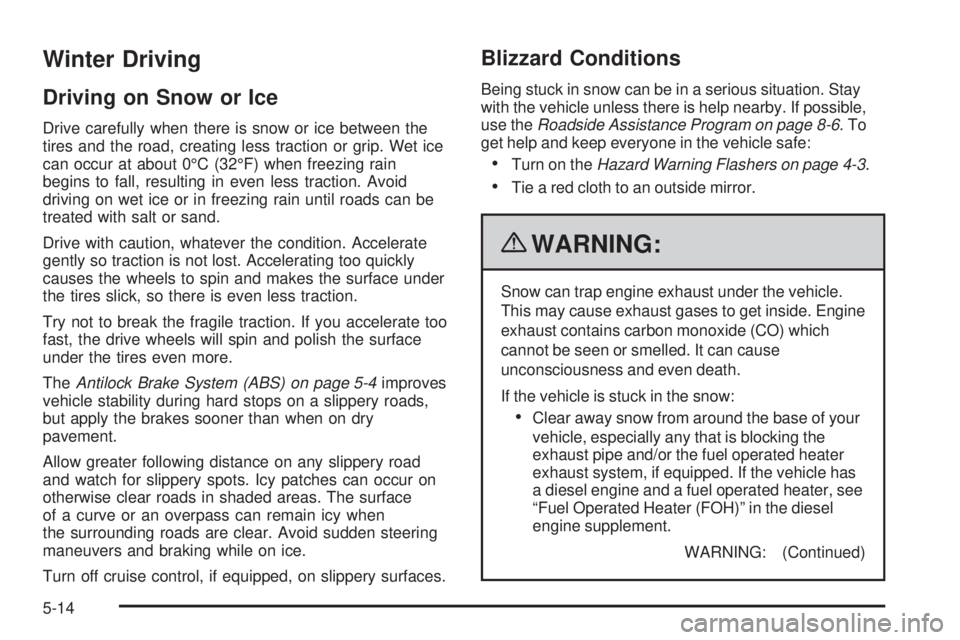
Winter Driving
Driving on Snow or Ice
Drive carefully when there is snow or ice between the
tires and the road, creating less traction or grip. Wet ice
can occur at about 0°C (32°F) when freezing rain
begins to fall, resulting in even less traction. Avoid
driving on wet ice or in freezing rain until roads can be
treated with salt or sand.
Drive with caution, whatever the condition. Accelerate
gently so traction is not lost. Accelerating too quickly
causes the wheels to spin and makes the surface under
the tires slick, so there is even less traction.
Try not to break the fragile traction. If you accelerate too
fast, the drive wheels will spin and polish the surface
under the tires even more.
TheAntilock Brake System (ABS) on page 5-4improves
vehicle stability during hard stops on a slippery roads,
but apply the brakes sooner than when on dry
pavement.
Allow greater following distance on any slippery road
and watch for slippery spots. Icy patches can occur on
otherwise clear roads in shaded areas. The surface
of a curve or an overpass can remain icy when
the surrounding roads are clear. Avoid sudden steering
maneuvers and braking while on ice.
Turn off cruise control, if equipped, on slippery surfaces.
Blizzard Conditions
Being stuck in snow can be in a serious situation. Stay
with the vehicle unless there is help nearby. If possible,
use theRoadside Assistance Program on page 8-6.To
get help and keep everyone in the vehicle safe:
•Turn on theHazard Warning Flashers on page 4-3.
•Tie a red cloth to an outside mirror.
{WARNING:
Snow can trap engine exhaust under the vehicle.
This may cause exhaust gases to get inside. Engine
exhaust contains carbon monoxide (CO) which
cannot be seen or smelled. It can cause
unconsciousness and even death.
If the vehicle is stuck in the snow:
•Clear away snow from around the base of your
vehicle, especially any that is blocking the
exhaust pipe and/or the fuel operated heater
exhaust system, if equipped. If the vehicle has
a diesel engine and a fuel operated heater, see
“Fuel Operated Heater (FOH)” in the diesel
engine supplement.
WARNING: (Continued)
5-14
Page 260 of 424
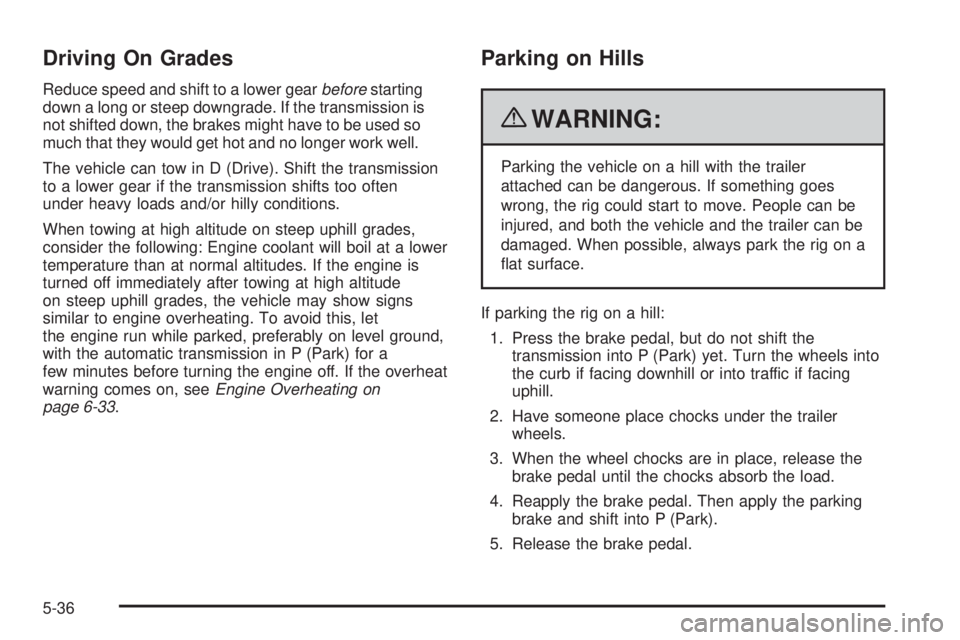
Driving On Grades
Reduce speed and shift to a lower gearbeforestarting
down a long or steep downgrade. If the transmission is
not shifted down, the brakes might have to be used so
much that they would get hot and no longer work well.
The vehicle can tow in D (Drive). Shift the transmission
to a lower gear if the transmission shifts too often
under heavy loads and/or hilly conditions.
When towing at high altitude on steep uphill grades,
consider the following: Engine coolant will boil at a lower
temperature than at normal altitudes. If the engine is
turned off immediately after towing at high altitude
on steep uphill grades, the vehicle may show signs
similar to engine overheating. To avoid this, let
the engine run while parked, preferably on level ground,
with the automatic transmission in P (Park) for a
few minutes before turning the engine off. If the overheat
warning comes on, seeEngine Overheating on
page 6-33.
Parking on Hills
{WARNING:
Parking the vehicle on a hill with the trailer
attached can be dangerous. If something goes
wrong, the rig could start to move. People can be
injured, and both the vehicle and the trailer can be
damaged. When possible, always park the rig on a
flat surface.
If parking the rig on a hill:
1. Press the brake pedal, but do not shift the
transmission into P (Park) yet. Turn the wheels into
the curb if facing downhill or into traffic if facing
uphill.
2. Have someone place chocks under the trailer
wheels.
3. When the wheel chocks are in place, release the
brake pedal until the chocks absorb the load.
4. Reapply the brake pedal. Then apply the parking
brake and shift into P (Park).
5. Release the brake pedal.
5-36
Page 313 of 424
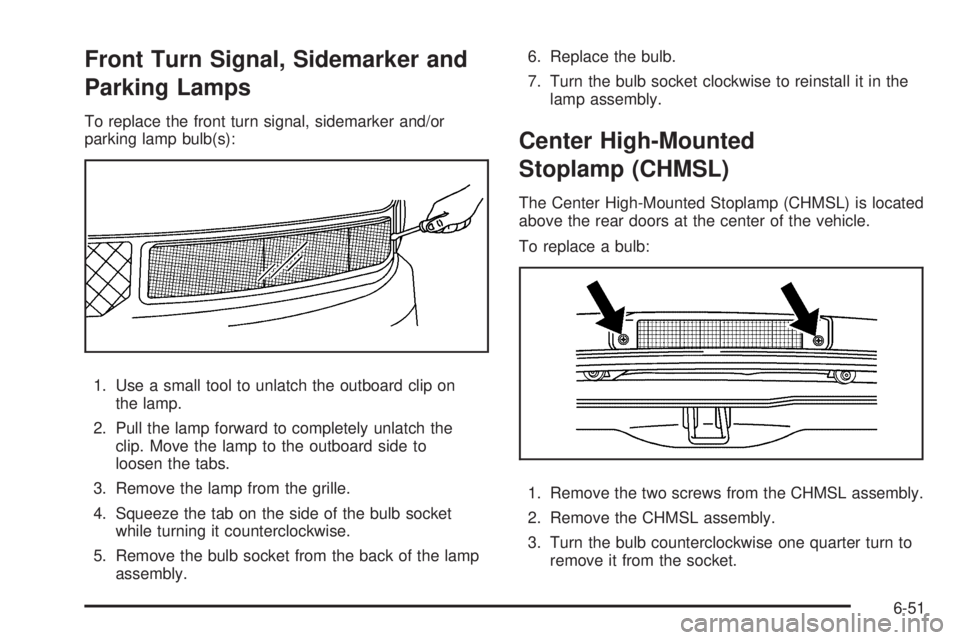
Front Turn Signal, Sidemarker and
Parking Lamps
To replace the front turn signal, sidemarker and/or
parking lamp bulb(s):
1. Use a small tool to unlatch the outboard clip on
the lamp.
2. Pull the lamp forward to completely unlatch the
clip. Move the lamp to the outboard side to
loosen the tabs.
3. Remove the lamp from the grille.
4. Squeeze the tab on the side of the bulb socket
while turning it counterclockwise.
5. Remove the bulb socket from the back of the lamp
assembly.6. Replace the bulb.
7. Turn the bulb socket clockwise to reinstall it in the
lamp assembly.
Center High-Mounted
Stoplamp (CHMSL)
The Center High-Mounted Stoplamp (CHMSL) is located
above the rear doors at the center of the vehicle.
To replace a bulb:
1. Remove the two screws from the CHMSL assembly.
2. Remove the CHMSL assembly.
3. Turn the bulb counterclockwise one quarter turn to
remove it from the socket.
6-51
Page 349 of 424
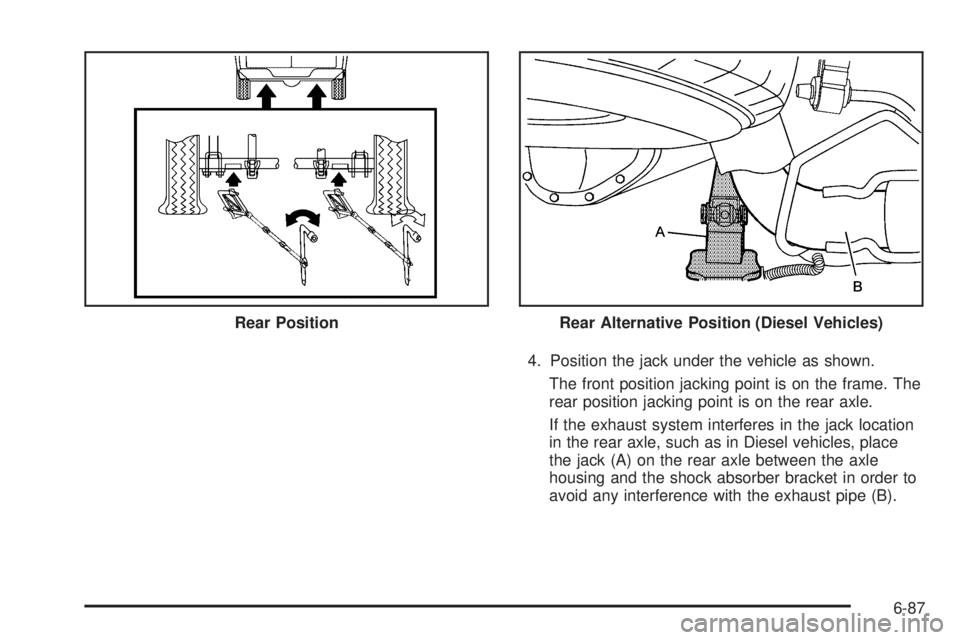
4. Position the jack under the vehicle as shown.
The front position jacking point is on the frame. The
rear position jacking point is on the rear axle.
If the exhaust system interferes in the jack location
in the rear axle, such as in Diesel vehicles, place
the jack (A) on the rear axle between the axle
housing and the shock absorber bracket in order to
avoid any interference with the exhaust pipe (B). Rear Position
Rear Alternative Position (Diesel Vehicles)
6-87
Page 359 of 424
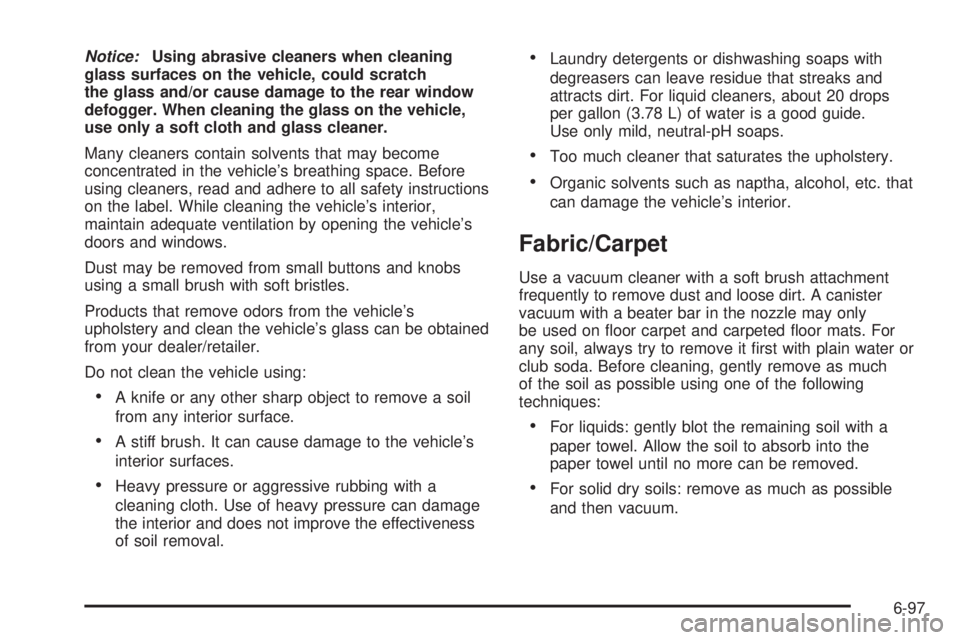
Notice:Using abrasive cleaners when cleaning
glass surfaces on the vehicle, could scratch
the glass and/or cause damage to the rear window
defogger. When cleaning the glass on the vehicle,
use only a soft cloth and glass cleaner.
Many cleaners contain solvents that may become
concentrated in the vehicle’s breathing space. Before
using cleaners, read and adhere to all safety instructions
on the label. While cleaning the vehicle’s interior,
maintain adequate ventilation by opening the vehicle’s
doors and windows.
Dust may be removed from small buttons and knobs
using a small brush with soft bristles.
Products that remove odors from the vehicle’s
upholstery and clean the vehicle’s glass can be obtained
from your dealer/retailer.
Do not clean the vehicle using:
•A knife or any other sharp object to remove a soil
from any interior surface.
•A stiff brush. It can cause damage to the vehicle’s
interior surfaces.
•Heavy pressure or aggressive rubbing with a
cleaning cloth. Use of heavy pressure can damage
the interior and does not improve the effectiveness
of soil removal.
•Laundry detergents or dishwashing soaps with
degreasers can leave residue that streaks and
attracts dirt. For liquid cleaners, about 20 drops
per gallon (3.78 L) of water is a good guide.
Use only mild, neutral-pH soaps.
•Too much cleaner that saturates the upholstery.
•Organic solvents such as naptha, alcohol, etc. that
can damage the vehicle’s interior.
Fabric/Carpet
Use a vacuum cleaner with a soft brush attachment
frequently to remove dust and loose dirt. A canister
vacuum with a beater bar in the nozzle may only
be used on floor carpet and carpeted floor mats. For
any soil, always try to remove it first with plain water or
club soda. Before cleaning, gently remove as much
of the soil as possible using one of the following
techniques:
•For liquids: gently blot the remaining soil with a
paper towel. Allow the soil to absorb into the
paper towel until no more can be removed.
•For solid dry soils: remove as much as possible
and then vacuum.
6-97
Page 371 of 424
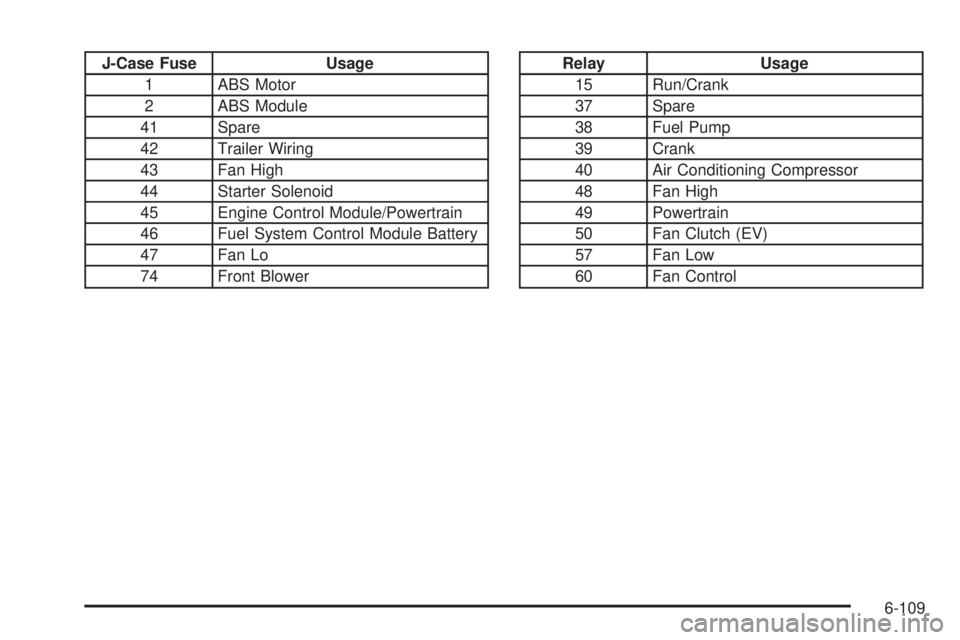
J-Case Fuse Usage
1 ABS Motor
2 ABS Module
41 Spare
42 Trailer Wiring
43 Fan High
44 Starter Solenoid
45 Engine Control Module/Powertrain
46 Fuel System Control Module Battery
47 Fan Lo
74 Front BlowerRelay Usage
15 Run/Crank
37 Spare
38 Fuel Pump
39 Crank
40 Air Conditioning Compressor
48 Fan High
49 Powertrain
50 Fan Clutch (EV)
57 Fan Low
60 Fan Control
6-109
Page 411 of 424

A
Accessories and Modifications............................ 6-3
Accessory Power............................................3-23
Accessory Power Outlets.................................4-14
Additives, Fuel................................................. 6-7
Add-On Electrical Equipment...........................6-104
Air Cleaner/Filter, Engine.................................6-19
Air Conditioning..............................................4-15
Airbag
Adding Equipment to Your Airbag-Equipped
Vehicle...................................................2-78
Airbag System
Airbag Off Switch........................................2-69
How Does an Airbag Restrain?......................2-66
Passenger Sensing System...........................2-72
Servicing Your Airbag-Equipped Vehicle..........2-77
What Makes an Airbag Inflate?......................2-66
What Will You See After an Airbag Inflates?....2-67
When Should an Airbag Inflate?....................2-65
Where Are the Airbags?...............................2-62
Airbags
Off Light.....................................................4-24
Passenger Status Indicator...........................4-26
Readiness Light..........................................4-23
System Check.............................................2-60
All-Wheel Drive...............................................6-45
All-Wheel-Drive (AWD) System........................... 5-7Antenna
Fixed Mast.................................................4-78
Antilock Brake System (ABS)............................. 5-4
Warning Light.............................................4-29
Appearance Care
Aluminum Wheels......................................6-101
Care of Safety Belts....................................6-99
Chemical Paint Spotting..............................6-102
Cleaning Exterior Lamps/Lenses..................6-100
Fabric/Carpet..............................................6-97
Finish Care...............................................6-100
Finish Damage..........................................6-102
Instrument Panel, Vinyl, and Other Plastic
Surfaces.................................................
6-98
Interior Cleaning..........................................6-96
Sheet Metal Damage..................................6-102
Tires........................................................6-102
Underbody Maintenance.............................6-102
Washing Your Vehicle...................................6-99
Weatherstrips..............................................6-99
Windshield and Wiper Blades......................6-101
Ashtray.........................................................4-15
Assistance Program, Roadside........................... 8-6
Audio System.................................................4-59
Audio Steering Wheel Controls......................4-77
Radio Reception..........................................4-77
Setting the Clock.........................................4-60
Theft-Deterrent Feature................................4-76
1
Page 418 of 424
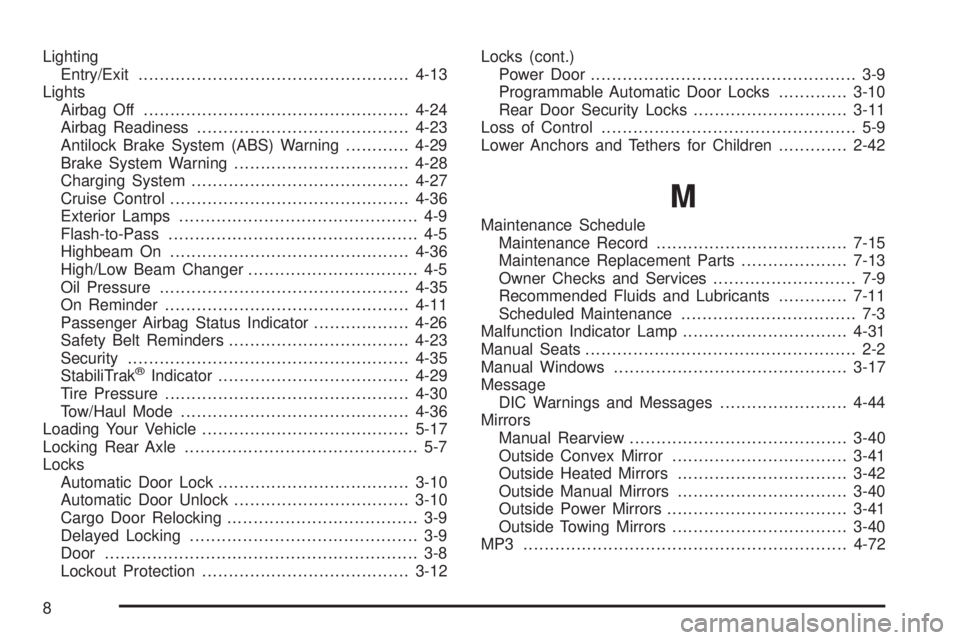
Lighting
Entry/Exit...................................................4-13
Lights
Airbag Off..................................................4-24
Airbag Readiness........................................4-23
Antilock Brake System (ABS) Warning............4-29
Brake System Warning.................................4-28
Charging System.........................................4-27
Cruise Control.............................................4-36
Exterior Lamps............................................. 4-9
Flash-to-Pass............................................... 4-5
Highbeam On.............................................4-36
High/Low Beam Changer................................ 4-5
Oil Pressure...............................................4-35
On Reminder..............................................4-11
Passenger Airbag Status Indicator..................4-26
Safety Belt Reminders..................................4-23
Security.....................................................4-35
StabiliTrak
®Indicator....................................4-29
Tire Pressure..............................................4-30
Tow/Haul Mode ...........................................4-36
Loading Your Vehicle.......................................5-17
Locking Rear Axle............................................ 5-7
Locks
Automatic Door Lock....................................3-10
Automatic Door Unlock.................................3-10
Cargo Door Relocking.................................... 3-9
Delayed Locking........................................... 3-9
Door ........................................................... 3-8
Lockout Protection.......................................3-12Locks (cont.)
Power Door.................................................. 3-9
Programmable Automatic Door Locks.............3-10
Rear Door Security Locks.............................3-11
Loss of Control................................................ 5-9
Lower Anchors and Tethers for Children.............2-42
M
Maintenance Schedule
Maintenance Record....................................7-15
Maintenance Replacement Parts....................7-13
Owner Checks and Services........................... 7-9
Recommended Fluids and Lubricants.............7-11
Scheduled Maintenance................................. 7-3
Malfunction Indicator Lamp...............................4-31
Manual Seats................................................... 2-2
Manual Windows............................................3-17
Message
DIC Warnings and Messages........................4-44
Mirrors
Manual Rearview.........................................3-40
Outside Convex Mirror.................................3-41
Outside Heated Mirrors................................3-42
Outside Manual Mirrors................................3-40
Outside Power Mirrors..................................3-41
Outside Towing Mirrors.................................3-40
MP3 .............................................................4-72
8